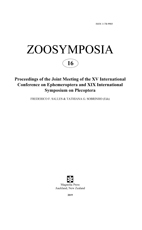Abstract
The adults of the Nearctic species of the Holarctic perlodid genus Kogotus are reviewed using scanning electron microscopy, illustrations, and variation in the barcode region of the mitochondrial DNA Cytochrome Oxidase c Subunit I (COI) gene. Adults of Kogotus modestus (Banks, 1908) examined from Colorado, Montana, New Mexico, Nevada, Utah, and Wyoming are usually more lightly colored with indistinct head and pronotal markings and, in the male, the hemitergal tips are subequal in length and width. Adults of K. nonus (Needham & Claassen, 1925) examined from California, Idaho, Montana, Nevada, Oregon, Washington, and Wyoming are darker and the head and pronotum more distinctly marked and, in the male, the tips of the hemitergal lobes are more slender, 2.0–2.3X length to width. In both species, no differences in the epiproct were noted in either in situ or everted. The everted internal invagination of the epiproct is a complex structure covered by overlapping golden spines. The fully everted aedeagus of both taxa are also virtually identical. The adult female subgenital plate of K. modestus typically covers or extends beyond sternum 9, whereas in K. nonus the subgenital plate usually covers ½ of sternum 9. However, the length of the subgenital plates varies often within and between populations of both species. No discernable differences were noted in the eggs of either species or the putative hybrids. Where both species overlapped (Idaho, Montana, and Wyoming), putative hybrids may be apparently present, making specific determinations problematic.

